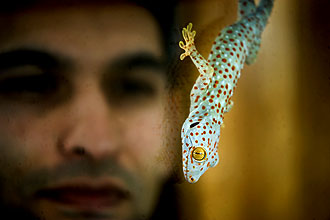Stuck Up
She's four years old, lives in a lab in the Boggs building and is among a family of reptiles inspiring development of a new reusable dry adhesive. She's a Tokay gecko named Nikki.

Noshir Pesika developed polymer-based dry adhesive structures that mimic the adhesive system on the feet of his gecko, Nikki. (Photos by Paula Burch-Celentano)
"We're working to develop a synthetic dry adhesive following the same science behind what nature has evolved," says Noshir Pesika, an assistant professor of chemical and biomolecular engineering.
When scientists began studying the gecko adhesive system, they discovered that geckos stick not by suction, or capillary forces, or by sticky substances on their toes, but by weak electromagnetic forces called van der Waals interactions.
It is the force of millions of nanoscale "split hairs" contacting a surface at once that gives the gecko a grip so strong it can hold its own body weight by a single toe, Pesika says.
Many research groups are fabricating structures of hair-like fibers attempting to replicate the gecko adhesive system.
In his laboratory, Pesika developed polymer-based dry adhesive structures that mimic the gecko adhesive system.

Nikki's sticky feet are inspiring research at Tulane.
Along with collaborators at the University of Californiaâ“Santa Barbara and Lewis & Clark College, Pesika has developed an innovative and simple technique to incorporate tilt in the hairy fibers. The angled fibers more closely duplicate the natural curve of the gecko hairs, which Pesika says exploits friction forces to enhance adhesion.
"We have structures that are already working," Pesika says. "Our aim is to further improve adhesion and simplify the processing scheme to make the technology attractive to an industrial market."
Pesika anticipates that dry adhesives may be used as self-stick notes and page tabs that would not leave a residue, as bandages that would not fall off when wet, and possibly as adhesive pads on astronaut's shoes.
They have an advantage over traditional "sticky" adhesives, Pesika says, because they are a solid material that would not collect dirt and would still adhere in water or in space, where glue would evaporate.
Belinda Lacoste is a student studying journalism in the School of Continuing Studies and a staff member who writes for the School of Science and Engineering.
